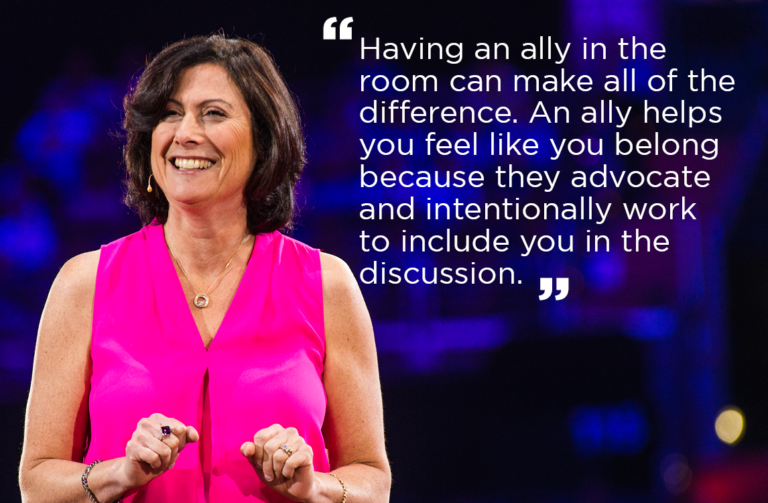I have been in high tech almost my whole career. And many times, I have found myself to be the ONLY woman in the room — a lonely place to be. Have you ever had that experience, being THE ONLY one in a group of people? It’s painful. I’ve felt dismissed, disrespected or simply not heard – as if I were invisible. Now, I don’t believe any of the men in those meetings intentionally excluded me. But here’s something I’ve learned over the years: one single ally in the room can make all the difference in the world.
I’ve had the privilege to work with many men who have been my allies and have worked with courage and intention to advocate, include and sponsor me. As I have stepped into awareness the last few years, I have learned that when you work with intention to be an ally and empower other allies, you can create an inclusive environment where everyone in the room has a voice, is valued and can feel emboldened to speak up and share their authentic selves. To build inclusion through allyship takes focus, intention and acute awareness of the environment.
Becoming an ally is the first step in the journey.
Last fall I introduced the #BeCOME framework, which focused on what you can do to become an ally—and the actionable steps you can take to build healthier workplace cultures.
BeCOME: Taking intentional action to Connect and network into the communities. Outreach is examining your recruiting and hiring practices. Mentorship is taking your relationship to another level. And Empowerment is about the inclusive environment you create when you are an ally.
To learn more about how to BeCOME an ally and bring more women into your network, organization and leadership roles, take a look at my blog post, TED talk or website, gavriellaschuster.com.

The next step on this journey requires us to dig into the actions of ALLIES more deeply. This is a double click on the role and the actions of allies in creating inclusive and empowering environments. To grow together, we need to share what it means to be an ally and the specific behaviors allies exhibit every single day.
It is my mission to bring more intentionality to allyship. Being an ally should be a conscious decision. I want us to get to a stage where allyship is so infiltrated into the technology industry—so normal—that there isn’t a need for us to have these conversations anymore. So, I am excited to share with you this second stage of my framework:
ALLIES.
Being an ally is not as hard as you think. I developed this new framework that is simple and easy to remember. When you find yourself on a team or in a meeting and you realize that someone in that group could use an ally, I encourage you to consider taking any one of these six actions:

Advocate | Put yourself in the shoes of the ones you want to ally with and consider what support they need “in the moment.” Support the idea the person just shared. Amplify or expand upon what they said to encourage more conversation and inclusion.
Listen | Listen to what others have to say, regardless of their age, gender or race. Listen to learn. Be curious and ask questions. Too often we listen to respond. Take the time to really understand someone else’s perspective.
Lift | Lift up your colleagues to build their confidence. It is very easy in an environment where a woman is constantly dismissed or disrespected for her to lose confidence and stop speaking up. It is also easy to criticize and find fault with other people’s ideas. Allies work with intention to highlight the positives instead of the negatives. They recognize the value of everyone’s contributions and they build the confidence of others with their support.
Include | When you walk into a meeting, a team, or a group, seek out those who are not sharing their ideas and work with intention to include them in the conversation. Look around the room and encourage everyone to contribute. When someone speaks up, demonstrate that their opinion matters.
Elevate | Elevate individuals by providing them opportunities to be more visible. That can be as easy as amplifying their voice and making sure they receive credit for their ideas. Look for new projects or opportunities for the individual to demonstrate leadership and become more visible.
Sponsor | Be supportive of individuals even when they’re not in the room. Make sure they are considered for new roles, new projects or new opportunities they might not even be aware of. Seek opportunities for that individual to grow and take on more leadership.
As I developed the #ALLIES framework, I was reminded of the many examples of allyship I’ve witnessed throughout my career. Over the next few weeks I will share my stories, the perspectives of those who have been an ally to me, and examples of others who demonstrate these actions.
Take a listen to what Phil Sorgen, CRO for RingCentral, has to say about his experience as an Ally. And stay tuned for my next LinkedIn article to hear more incredible stories of ALLIES.













